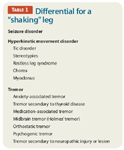Teen troubled by a trembling leg
A 15-year-old girl presents to your office with a chief complaint of a "trembling leg" that has been bothering her for a few days.

Key Points
The Case
A 15-year-old girl presents to your office with a chief complaint of a "trembling leg" that has been troubling her for a few days. She first noticed it a few days ago while sitting down in a movie theater. It has affected her right leg more than her left. The trembling mostly occurs during the day but is also noticeable at night; she's not sure if it happens when she is asleep.
Yesterday, the trembling was severe enough that she went to the emergency department (ED) of the local children's hospital. You look at the ED paperwork and note that the workup included a complete blood count (CBC), a metabolic panel, and a C-reactive protein (CRP) level. All of the results were within normal limits.
NO TIME TO TREMBLE
You've known this patient since she was a toddler and are aware that she has had an unremarkable medical history. She has had no hospitalizations or surgeries. She had her menarche at the age of 13 and has had regular painless periods, the latest one beginning 4 or 5 days ago. She has had occasional episodes of food allergy. There have been no obvious recent psychological traumas. She denies sexual activity.
In terms of social and family history, the patient lives with her mother, father, and sister, who is 2 years younger than the patient. Your patient is doing well as a sophomore in high school and is active in the school choir. She is looking forward to taking driver's education classes in the summer. Her younger sister has had a benign history, as have the parents. There is no family history of seizure, tic, or psychiatric disorders. Her father is a psychologist and seems convinced that she is having a "hysterical conversion."
Your physical examination of this patient is unremarkable. During your history and exam, you don't notice any eye-blinking movements or repetitive throat-clearing noises. The patient is afebrile with a normal heart and respiratory rate. She is not sweating. There is no exophthalmos or neck mass.
You pay particular attention to the neurologic examination. Cranial nerves are intact. Strength and tone are symmetric. Gait and station are normal, with the exception of a noticeable tremor in the right leg when the patient is sitting, standing, and lying down. According to your patient, the tremor doesn't seem to interfere with walking, running, or other activities. The tremor involves the right thigh mostly, and the excursion of the right leg is approximately half an inch. The tremor has a regular rhythm and amplitude. This is not fasciculation or a muscle cramp. You note that the patient cannot voluntarily stop the movement. Sensory exam and reflexes are normal.
SHAKING UP A DIFFERENTIAL

What about a new seizure disorder? Seizures can be classified as partial or generalized. This would be a partial seizure. In a patient with simple partial seizures, consciousness is retained, as opposed to complex partial seizures, in which a patient experiences loss of consciousness. The trembling leg could represent a simple focal motor seizure involving the leg only. These seizures, however, are typically brief, with an average duration of 90 seconds. The chronic, continuous leg shaking in your patient makes this diagnosis less likely.
There is a rare entity of focal motor status epilepticus known as epilepsia partialis continua. To rule out this rare diagnosis, further testing may be required.